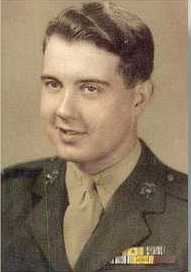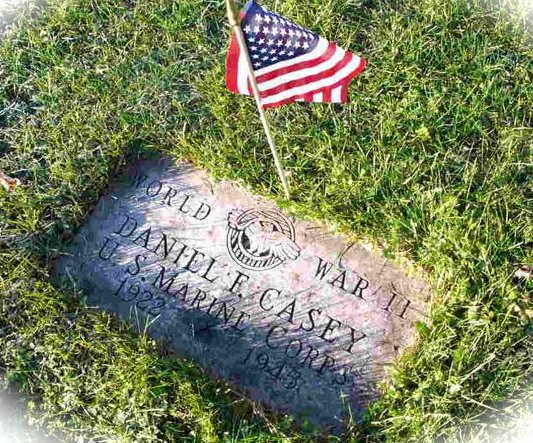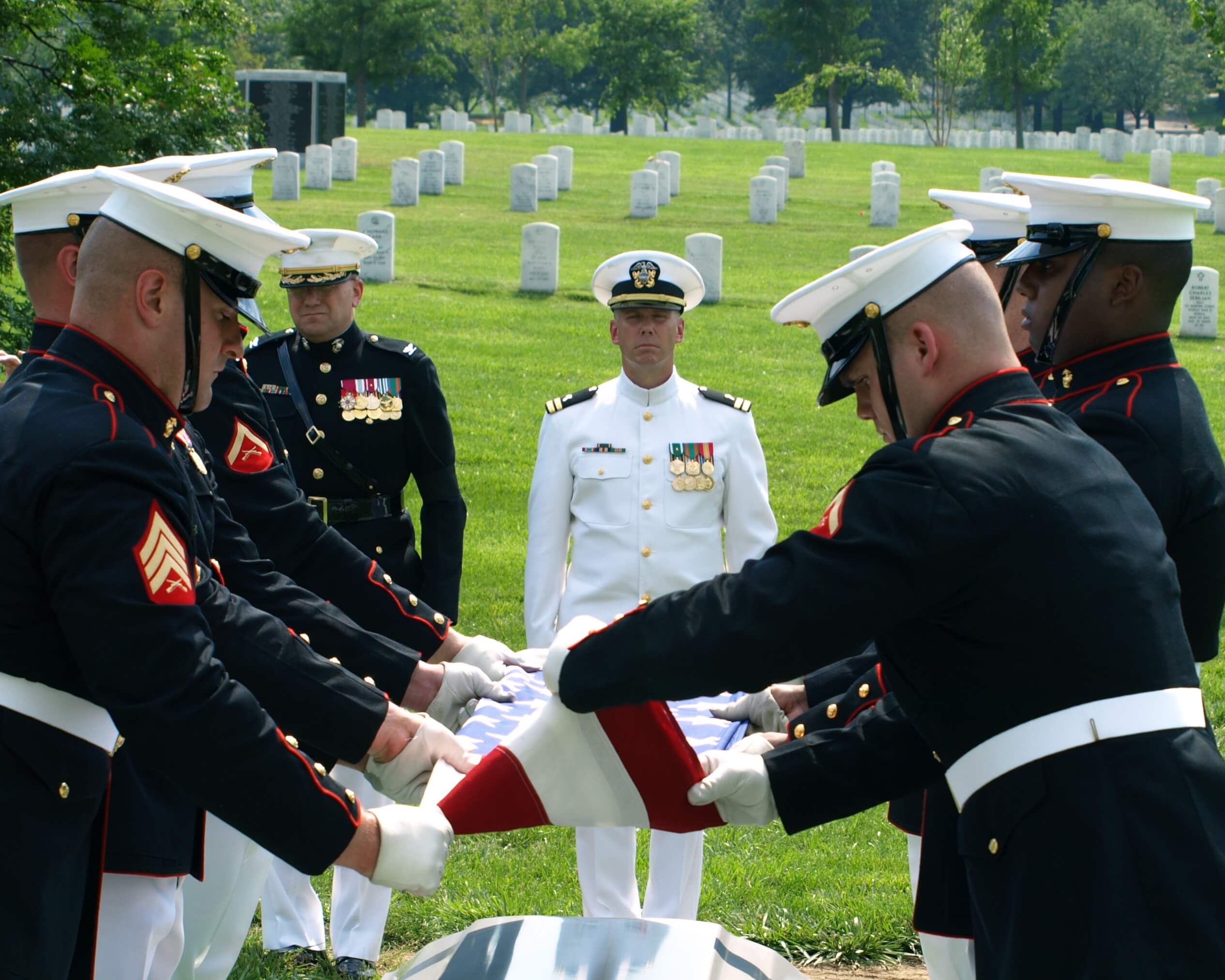Iwo Jima hero reburied in Arlington National Cemetery 63 years later
Widow leads effort to transfer remains from Cheektowaga cemetery
By Tom Buckham
Courtesy of the Buffalo News
13 June 2008
Mount Calvary Cemetery in Cheektowaga was the gravesite for Marine Second Lieutenant Daniel F. Casey before long efforts by his widow succeeded in earning him a place at Arlington.
It might have been his gregarious personality, the twinkling eyes, the ruddy Irish face or the romantic pursuit — maybe all of those. Eleanor Adkins can’t quite put her finger on it, but something about Marine Second Lieutenant Daniel Francis Casey of Buffalo stayed with her for all these years.
The intangible feeling took hold when they met as 14-year-olds at a 1936 dance in Pennsylvania. It grew through their correspondence, his enlistment in the Marine Corps, their 1941 wedding, the 1944 birth of their only child, Casey’s heroic death on Iwo Jima at age 23 and his unremarkable funeral here.
Even after her remarriage, and more children, she never quite put him out of her mind. Thursday, 63 years after Dan Casey died during brutal combat on the Pacific island, 85-year-old Eleanor Adkins looked on proudly as he was reburied with military honors in Arlington National Cemetery.
The traditional military ceremony— flag-draped casket on horse-drawn caisson, Marine honor guard in dress blues, rifle salute, presentation of the folded American flag to the widow — followed a protracted legal and logistical process that required a Buffalo lawyer’s dogged work, a state judge’s signature and the transfer of Casey’s remains from an ordinary grave in a Cheektowaga cemetery.
“I’ll bet he’s smiling down and chuckling that he finally got me back,” said Adkins, who hopes to be buried beside him one day, as Arlington rules permit. The journey to sacred ground began nine months ago when Adkins’ son-in-law, Thomas P. Murphy of McLean, Virginia, sought Buffalo lawyer Glenn E. Murray’s help in removing the coffin from Mount Calvary Cemetery.
Eleanor Adkins had taken the first step by meeting with three of her late husband’s four surviving nieces and nephews, whose consent was required because they own the family plot. She was received “warmly and with immense kindness,” Murray noted in a petition filed on her behalf with the Erie County clerk. But the family never signed the disinterment authorization.
In asking State Supreme Court to clear the way, Murray, an Army veteran who placed an American flag at Casey’s grave right after starting on the case, detailed the Marine’s “extraordinary heroism” on Iwo Jima, for which he was awarded the Navy Cross posthumously in 1947. The medal ranks with the Army Distinguished Service Cross and Air Force Cross as the highest military decoration after the Medal of Honor.
During an attack against a heavily fortified Japanese position on the morning of March 6, 1945, “Casey dauntlessly led his men forward despite the terrific enemy fire which wounded or killed one-half of his platoon within 20 minutes,” the medal citation said.
“Undeterred by the powerful blasts from the hostile position and from the seriousness of wounds he had sustained in the bitter action, he refused to halt or slacken his progress and, by sheer momentum of his charge, enabled the whole company to advance,” the document continued.
“Refusing medical aid from the attending corpsman until the wounded members of his platoon had first been cared for, he valiantly continued the advance with the remnants of his platoon until he fell, mortally wounded, from a second hit.”
The citation praised Casey’s “courageous fighting spirit, perseverance and indomitable determination in the face of insuperable odds.”
Distraught, and unable to pay for his funeral after the war, the young widow let his family plan the service and burial in Buffalo.
She vaguely remembers coming up from her parents’ home in Pennsylvania and sitting in a crowded funeral home where three other wakes were going on at the same time. There was no American flag, no military honor guard.
“I don’t remember the burial at all,” she said from her home in northwest Washington, D. C., across the Potomac from Arlington.
The young widow went on with her life. She eventually married E. Robert Adkins and settled in Washington, where he became a college professor and she was an interior designer and homemaker. Her second husband adopted her son, Danny, and they had three children of their own.
She traveled to Buffalo for the presentation of the Navy Cross and afterward stayed in touch with Casey’s mother, Josephine, who remained close to Danny until she died in 1983.
Hidden away all along were a trove of wartime letters, “easily 100 of them,” Adkins had received from her young Marine. Those letters provide ample evidence of Casey’s love for his wife and son, who rarely saw him after he went off to war in 1943, just two years into the marriage, Murray noted in his court filing.
In one letter, Casey said he had misplaced a pair of their son’s baby boots and was relieved when he finally found those good-luck charms. The boots came home with his body.
On March 2, 1945, four days before he was killed, Casey wrote:
“This is just a short sugar report from my command post to let you know that the fighting Irish are really fighting, and though the going is tough we are about to push them into the sea. I wish I could spend a couple of days or even minutes with you my sweet. Remember, whatever happens I love you with all my heart and soul want to spend the rest of my life making you happy.”
After she and her second husband divorced years ago, Adkins reread the letters and showed them to Danny, who, though he never served, was inspired to become a veterans advocate.
As a military widow, she was eligible to shop at Fort Myer, the Army post next to Arlington National Cemetery. The path to the commissary took her past the immaculate burial ground and its endless rows of white headstones — often while funerals were taking place.
“I started thinking, ‘Maybe I can have that done for my husband some day, and I could be buried next to him,’ ” Adkins said.
She talked it over with her children, and Murphy, a Virginia lawyer who is married to her daughter, Lise, contacted Murray.
After reading the record, State Supreme Court Justice Patrick E. NeMoyer was eager to help. Adkins was not required to witness the signing of NeMoyer’s order, in which he expressed “profound gratitude” for the Marine’s long-ago sacrifice, but she came to Buffalo anyway at Murray’s invitation.
The occasion caused a stir in the courthouse, where the Irish octogenarian posed for pictures with the Irish judge and her Irish lawyer, while sitting in the judge’s chair. The night before, Murray treated Adkins to Buffalo chicken wings at the Anchor Bar and German oompah music at Ulrich’s Tavern.
Casey “is finally getting the burial he always deserved,” Murray said before flying to Washington for Thursday’s ceremony. It was followed at the Fort Myer officers club by what Adkins described as “an old-fashioned Irish wake.”
NOTE: Daniel F. Casey was laid to rest at Arlington National Cemetery on Thursday, 12 June 2008.
Second Lieutenant, U.S. Marine Corps (Reserve)
Company A, 1st Battalion, 9th Marines, 3d Marine Division
Date of Action: March 6, 1945
Citation: The Navy Cross is presented to Daniel F. Casey, Second Lieutenant, U.S. Marine Corps (Reserve), for extraordinary heroism as a Platoon Leader, attached to Company A, First Battalion, Ninth Marines, Third Marine Division, during operations against enemy Japanese forces on Iwo Jima, Volcano Islands, 6 March 1945.
When his group was designated as the assault platoon of an early morning attack against a heavily fortified Japanese position, Second Lieutenant Casey dauntlessly led his men forward despite the terrific enemy fire which wounded or killed one-half of his platoon within twenty minutes. Undeterred by the powerful blasts from the hostile position and from the seriousness of wounds he had sustained in the bitter action, he refused to half or slacken his progress and, by sheer momentum of his charge, enabled the whole company to advance. Refusing medical aid from the attending corpsman until the wounded members of his platoon had first been cared for, he valiantly continued the advance with the remnants of his platoon until he fell, mortally wounded, from a second hit.
His courageous fighting spirit, perseverance and indomitable determination in the face of insuperable odds reflect the highest credit upon Second Lieutenant Casey and upon the United States Naval Service. He gallantly gave his life for his country.
Approved by the Secretary of the Navy on January 15, 1947
Born: at Gleasonton, Pennsylvania
Home Town: Buffalo, New York
Michael Robert Patterson was born in Arlington and is the son of a former officer of the US Army. So it was no wonder that sooner or later his interests drew him to American history and especially to American military history. Many of his articles can be found on renowned portals like the New York Times, Washingtonpost or Wikipedia.
Reviewed by: Michael Howard



